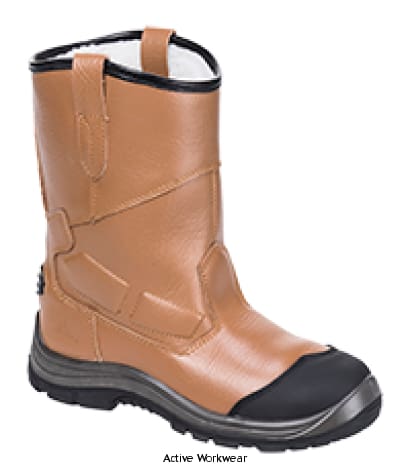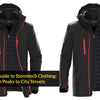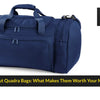Stepping into Safety: The Essentiality of Rigger Boots for Linemen
- by Mike Johnson

Working as a lineman is no easy feat. You're faced with demanding tasks and hazardous environments on a daily basis, which is why having the right gear is absolutely essential. And when it comes to footwear, rigger safety boots are a lineman's best friend. These boots are specially designed with a range of safety features that not only keep you protected but also comfortable throughout your workday.
At Active Workwear, we understand the importance of quality rigger safety boots, and we want to make sure you have all the information you need to make the best choice for your needs. So, let's dive into the essential features that make these boots a must-have for any lineman.
Boot Soles with Traction Support and Deep Treading
Working on different surfaces is just part of the job when you're a lineman. One minute, you're climbing up a smooth electric pole, and the next, navigating through uneven terrain. That's why having rigger safety boots with serious traction support and deep treading is an absolute must. Trust me, the last thing you want is to slip or fall while you're up there doing your thing.
At Active Workwear, we understand the importance of having a secure grip on whatever surface you're tackling. That's why we've got a range of rigger safety boots that come equipped with soles specifically designed to provide excellent traction and deep treading.
Take the BEESWIFT LINED RIGGER BOOT FULL SAFETY WITH SCUFF CAP S1P SRC - RBLSSC, for example. This bad boy features a dual-density PU sole that's slip-resistant, giving you a secure grip no matter what surface you're working on. Whether it's wet, dry, or uneven terrain, you can count on these soles to keep you steady and sure-footed.


But it's not just about slip resistance; it's also about deep treading. These soles are designed with deep, aggressive lugs that really dig into the surface, providing incredible grip and stability. No more worrying about your feet slipping out from under you when you're climbing up that pole or navigating through rough terrain.
Electrical Hazard Rated Boots
Given the nature of a lineman's job, working around electricity is just part of the job. But that doesn't mean you should take any chances when it comes to your safety. That's why having rigger safety boots that are electrical hazard-rated is an absolute must.
Now, you might be wondering, "What exactly does 'electrical hazard rated' mean?" Well, it means that these boots have been thoroughly tested and certified to provide protection against electrical risks. They're designed to keep you safe from potential shocks, burns, or other electrical hazards that could occur while you're on the job.
One of our top picks is the CLICK PREMIUM LEATHER RIGGER SAFETY BOOT TAN S1P LINED - CF8. This bad boy not only meets electrical hazard requirements but also comes packed with other safety features that make it a lineman's dream.
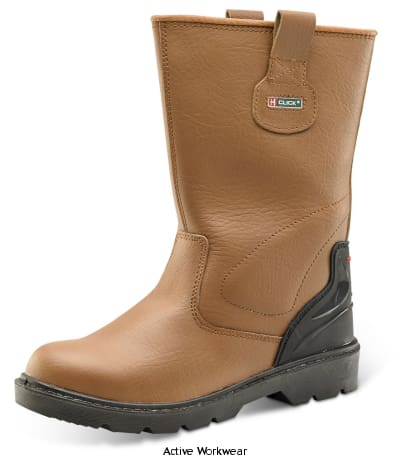

Let's start with the dual-density PU sole. This boot is slip-resistant and provides excellent traction on various surfaces, so you can tackle those poles and terrain with confidence. But that's not all—it also has a 200 Joule steel toe cap and steel midsole protection, keeping your feet safe from falling objects or any other potential hazards.
But what really sets this boot apart is its electrical hazard rating. You can be confident that it's been rigorously tested and certified to provide the protection you need when working around electricity. No more worrying about potential shocks or burns – these boots have got your back (or rather, your feet).
Ankle Support
Let's be real: When you're a lineman, your ankles go through a lot. All that climbing up and down poles or ladders and carrying heavy equipment can really take a toll. That's why having rigger safety boots with sturdy ankle support is an absolute game-changer.
At Active Workwear, we understand the importance of protecting and supporting your ankles throughout your workday. After all, the last thing you want is to be sidelined with an ankle injury. That's why we've got a range of rigger safety boots designed to provide superior ankle support, ensuring you can tackle those demanding tasks with confidence and comfort.
One of our top picks in this department is the DUNLOP PUROFORT RIGPRO FUR LINED WATERPROOF SAFETY RIGGER WELLINGTON BOOT - LJ2HR48. This boot is all about ankle support. It's got a robust design that cradles your ankles, providing much-needed stability and protection as you navigate through your workday.


But that's not all – this boot also comes equipped with a heavy-duty outsole that offers enhanced traction and slip resistance. So, not only are your ankles protected, but you're also getting a secure grip on whatever surface you're working on.
Waterproof Feature
As linemen have to work outdoors in all weather conditions, their boots should be waterproof. This will keep their feet dry even during heavy downpours, enhancing their comfort and performance.
The PORTWEST STEELITE SAFETY BLACK RIGGER BOOT SCUFF CAP STEEL TOE AND MIDSOLE S3 - FW29 is a great example of a waterproof boot. It features a water-resistant upper that acts like a shield, preventing any water from seeping in and soaking your socks.
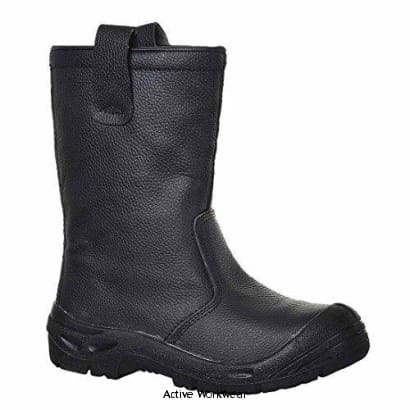

But that's not all – this boot is also packed with other safety features that make it a lineman's dream. It's got a steel toe cap and midsole, providing robust protection against potential hazards like falling objects or punctures. Plus, the scuff cap adds an extra layer of durability, ensuring these boots can withstand the wear and tear of your demanding job.
Boots with Safety Caps
Lastly, rigger safety boots should have built-in safety caps. These caps protect the toes from heavy impacts, ensuring the safety of the linemen.
The STEELITE PRO WATERPROOF RIGGER SAFETY BOOT S3 SCUFF CAP STEEL TOE AND MIDSOLE SIZE 38 -48 - FT12 ticks all the right boxes. It comes with a protective steel toecap and a steel midsole for enhanced safety.
Conclusion
Rigger safety boots are an essential safety gear for linemen. They provide the necessary protection against various hazards, ensuring the linemen can carry out their duties safely and comfortably. When selecting rigger safety boots, priority should be given to those offering traction support, electrical hazard rating, ankle support, waterproof features, and safety caps.
Visit Active Workwear, a trusted provider of high-quality workwear in the UK, to explore a wide range of rigger safety boots for linemen. With a devotion to customer satisfaction and safety, Active Workwear offers a variety of products that meet the highest safety protection standards. Discover the ideal pair of rigger safety boots for you today!
Your Guide to Linemen's Rigger Safety Boots: Essential FAQs
1. What are rigger safety boots?
Rigger safety boots are a type of pull-on safety footwear that is crafted to protect the feet and ankles of workers who operate on power lines, telecom cables, and other electrical systems. They are also known as power technicians, electrical line installers, repairers, and electrical power line technicians.
2. Why do linemen need rigger safety boots?
Linemen need rigger safety boots because they work in hazardous environments exposed to high voltages, extreme temperatures, sharp objects, and slippery surfaces. Rigger safety boots provide them with the following benefits:
- Steel toe caps to safeguard the toes from impact and compression injuries.
- Steel midsoles to prevent penetration from nails, screws, and other sharp objects.
- Water-resistant uppers to keep the feet dry and comfortable in wet conditions.
- Heat-resistant outsoles to withstand temperatures up to 300°C and prevent melting or burning.
- Anti-static properties to prevent electrostatic discharge and sparks that could ignite flammable materials.
- Slip-resistant soles provide traction and stability on uneven and slippery surfaces.
3. How do you choose the best rigger safety boots for linemen?
To choose the best rigger safety boots for linemen, you should consider the following factors:
- Fit and comfort: The boots should fit snugly but not too tightly and allow enough room for the toes to move. They should also have adequate cushioning, arch support, and breathability to prevent fatigue, blisters, and odours.
- Quality and durability: The boots should be created of top-notch materials that can withstand wear and tear and have strong stitching, seams, and fasteners. They should also have reinforced heels, toes, and ankles for extra protection and support.
- Certification and compliance: The boots should meet your industry and location's relevant safety standards and regulations. For example, in the UK, rigger safety boots should conform to EN ISO 20345:2011, which specifies the basic and additional requirements for protective footwear.
4. How to care for and maintain rigger safety boots?
To care for and maintain rigger safety boots, you should follow these steps:
- Clean them regularly. Use a soft brush or cloth to remove dirt and dust from the boots' surface. For stubborn stains, use a mild soap and water solution and rinse thoroughly. Avoid using harsh chemicals, solvents, or abrasives that could damage the material or the boots' protective features.
- Dry them properly. After cleaning, let the boots air dry in a well-ventilated area, away from direct heat or sunlight. Do not use a hair dryer, heater, or oven to speed up the drying process, as this could cause the boots' cracking, shrinking, or deformation.
- Condition them occasionally. Apply a leather conditioner or wax to the boots' leather parts to restore their shine and flexibility. This will also help prevent cracking, fading, and water damage. Do not use oil or grease, as this could clog the pores and reduce the leather's breathability.
- Store them correctly. When not in use, store the boots in a cool, dry, and dark place, away from moisture, heat, and sunlight. Do not stack or fold them, as this could cause creasing, bending, or distortion of the shape. You can also use cedar shoe trees or crumpled newspaper to keep the boots in shape and absorb any moisture or odour.
5. What are some common problems and solutions for rigger safety boots?
Some common problems and solutions for rigger safety boots are:
- The boots are too tight or too loose: If they are too tight, they could cause discomfort, pain, blisters, and circulation problems. If they are too loose, they could cause slipping, rubbing, and instability. To solve this problem, you should try adjusting the fit by using thicker or thinner socks, adding or removing insoles, or using shoe stretchers or pads.
- The boots are squeaking: If the boots are squeaking, it could be due to friction between the different parts of the boots, such as the sole, the heel, the upper, or the insole. To solve this problem, you should try lubricating the squeaky area with talcum powder, cornstarch, or WD-40. You can also try tightening or loosening the screws or nails that hold the parts together or replacing the worn-out parts.
- The boots smell: If the boots smell, it could be due to bacteria, fungi, or sweat that has accumulated inside them. To solve this problem, you should try cleaning and drying the boots thoroughly and using deodorizers, baking soda, or activated charcoal to eliminate the odour. You can also try changing your socks more often or using antibacterial or antifungal sprays or powders to prevent infection and inflammation

